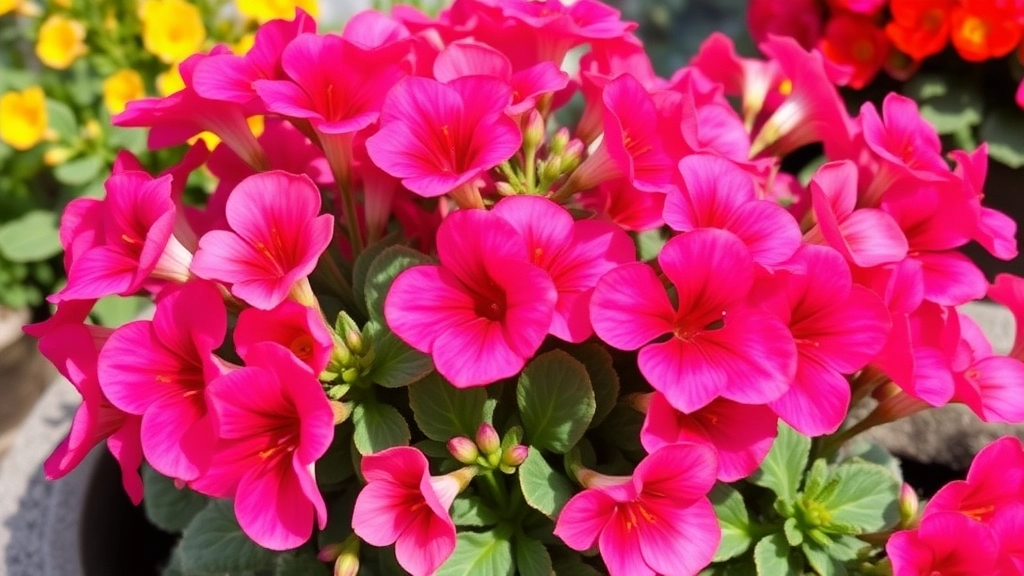Kalanchoe and Sunlight
If you’re wondering whether Kalanchoe thrives in full sun, you’re in the right place. Kalanchoe plants, known for their vibrant blooms and succulent leaves, can indeed handle a good amount of direct sunlight. However, it’s crucial to understand the best light conditions to ensure your plant stays healthy and happy.
Optimal Light Conditions
Placing your Kalanchoe in a spot where it receives plenty of morning sunlight can work wonders. However, be cautious of the intense afternoon sun, which can sometimes be too harsh. For indoor Kalanchoe, positioning them near a south-facing window usually provides the optimal light they need. Remember, keeping an eye on signs of too much sunlight, like leaf burn, can help you adjust their placement accordingly.
Best Light Conditions for Kalanchoe Growth
Have you ever wondered why your Kalanchoe isn’t thriving as you expected? The secret often lies in the light conditions.
Kalanchoe plants, known for their vibrant blooms and succulent leaves, flourish in bright, indirect sunlight.
Optimal Light Conditions
- Full Sun Exposure: Ideally, Kalanchoe requires around 6 hours of direct sunlight each day. This promotes healthy growth and abundant flowering.
- Indirect Light: While these plants love the sun, they also appreciate some respite from harsh rays, especially during peak afternoon hours.
- Natural Light: A south-facing window is often the best spot. The light should be bright but filtered to prevent leaf scorch.
Why Light Matters
Light is crucial for photosynthesis, the process by which plants convert sunlight into energy. Without adequate light, Kalanchoe may become leggy, with elongated stems and sparse leaves.
How to Position Kalanchoe for Full Sun Exposure
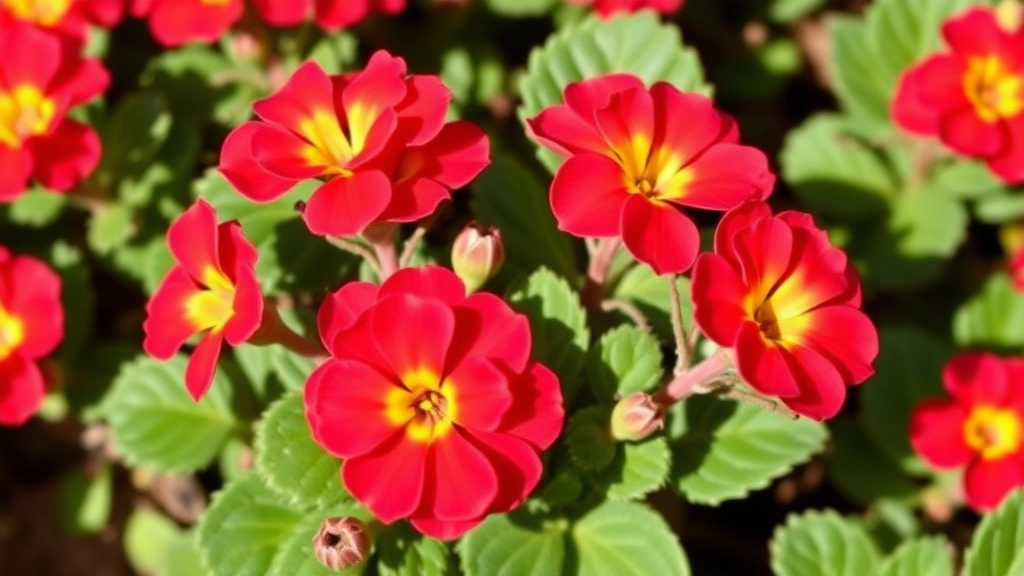
So, you’ve got your Kalanchoe and you want to make sure it gets all the sunshine it craves.
But how do you position it just right for full sun exposure?
Here are some straightforward tips that will help your Kalanchoe thrive in those sunny spots.
Find the Perfect Spot
- South-Facing Windows: If you’re keeping your Kalanchoe indoors, aim for a south-facing window. This direction usually gets the most sunlight throughout the day.
- Avoid Obstructions: Make sure there are no curtains, blinds, or other plants blocking the light. Your Kalanchoe needs that direct sun!
Outdoor Placement
- Direct Sunlight: If you’re placing your Kalanchoe outside, look for a spot that gets at least 6 hours of direct sunlight. Morning sun is great, as it’s not too harsh.
- Shelter from Wind: Position your plant where it’s sheltered from strong winds. This helps prevent stress and damage.
Rotation is Key
- Rotate Regularly: To ensure even growth, rotate your Kalanchoe every couple of weeks. This way, all sides get equal sun exposure.
Monitor Light Levels
- Watch for Changes: As the seasons change, so does the sun’s angle. Keep an eye on your plant and adjust its position if needed.
When it comes to nurturing indoor Kalanchoe, managing sunlight effectively is crucial for promoting healthy growth.
Are you worried about your Kalanchoe not thriving indoors?
Understanding its light requirements can make all the difference.
Kalanchoe plants thrive in bright, indirect sunlight. Here’s how to ensure they get the right amount:
– **Location**: Place your Kalanchoe near a south or west-facing window. This positioning maximizes sunlight exposure throughout the day.
– **Rotation**: Rotate the plant every few weeks. This ensures all sides receive equal light, promoting balanced growth.
As seasons change, so do light conditions.
– **Winter**: Days are shorter, so consider moving your Kalanchoe closer to the window or supplementing with grow lights.
– **Summer**: Be cautious of intense sunlight. If the plant is near a window, it may need to be moved back slightly to avoid scorching.
If your Kalanchoe isn’t getting enough light, you might notice:
– **Leggy Growth**: Stretched stems as the plant reaches for light.
– **Fading Colour**: Leaves losing their vibrant green hue.
For those darker corners of your home, consider using artificial lighting:
– **LED Grow Lights**: These mimic natural sunlight and can be adjusted for intensity.
– **Fluorescent Lights**: A cost-effective option that works well for Kalanchoe.
For more detailed information on how to care for your Kalanchoe, check out this [complete guide](https://planthq.org/caring-for-your-kalanchoe-succulent-a-complete-guide/). Additionally, if you notice any issues with your plant, such as drooping leaves, this [resource](https://planthq.org/how-to-fix-drooping-kalanchoe-leaves-causes-and-solutions/) can help you identify and solve the problem.
Outdoor Placement Tips for Kalanchoe in Hot Climates
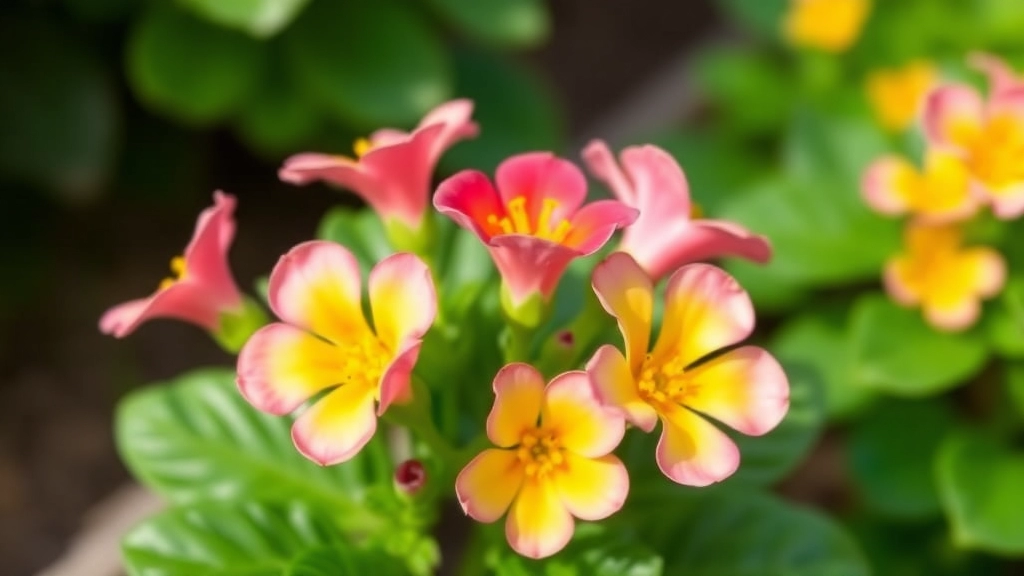
When considering the best outdoor placement for your Kalanchoe in hot climates, it’s essential to address the unique challenges posed by intense sunlight and heat. Many plant enthusiasts often worry about how to protect their beloved succulents from scorching conditions.
Optimal Placement Strategies
- Morning Sun, Afternoon Shade: Position your Kalanchoe where it can soak up morning sunlight but receive some relief during the hottest part of the day. This helps prevent sunburn while ensuring adequate light for growth.
- Use of Shade Cloth: In extremely hot areas, consider using a shade cloth to diffuse harsh sunlight. This can be particularly effective during peak summer months.
- Elevated Planters: Placing your Kalanchoe in elevated planters can improve air circulation, reducing heat stress and allowing for better drainage.
- Proximity to Other Plants: Grouping your Kalanchoe with other plants can provide some natural shade, creating a microclimate that’s more conducive to healthy growth.
Watering Considerations
- Regular Monitoring: In hot climates, your Kalanchoe may require more frequent watering due to increased evaporation. Check the soil moisture regularly to ensure it doesn’t dry out completely.
- Mulching: Apply a layer of organic mulch around your Kalanchoe to help retain soil moisture and regulate temperature.
Signs of Stress to Watch For
- Wilting Leaves: If you notice your Kalanchoe’s leaves wilting or curling, it may be a sign of heat stress or insufficient watering.
- Discoloration: Yellowing leaves can indicate sunburn or overexposure to intense sunlight.
When caring for Kalanchoe, it’s essential to strike the right balance with sunlight exposure. Too much sunlight can lead to distress in your plant, impacting its overall health and vibrancy.
Recognising Overexposure
Here are the key signs that your Kalanchoe might be getting too much sun:
– **Leaf Discoloration**: Yellowing or browning of leaves is often the first sign. The tips may turn brown, indicating sunburn.
– **Wilting**: Despite adequate watering, leaves may appear limp or wilted, suggesting stress from excessive light.
– **Leaf Drop**: If your Kalanchoe starts shedding leaves, it may be reacting to harsh sunlight.
– **Scorched Leaves**: Look for dry, crispy patches on the leaves, a clear indicator of sunburn.
– **Stunted Growth**: If growth seems sluggish or halted, it could be due to the plant trying to conserve energy in extreme conditions.
What to Do Next
If you notice any of these signs, it’s crucial to take action quickly.
– **Relocate**: Move your Kalanchoe to a spot with filtered sunlight or partial shade.
– **Monitor Watering**: Adjust your watering routine, as overexposure can lead to quicker evaporation.
For more detailed advice on caring for your Kalanchoe, check out our [care tips for Kalanchoe Blossfeldiana](https://planthq.org/care-tips-for-kalanchoe-blossfeldiana-variegated-succulents/) and learn how to [propagate Kalanchoe from leaves](https://planthq.org/how-to-propagate-kalanchoe-from-leaves-successfully/).
How to Prevent Kalanchoe Sunburn
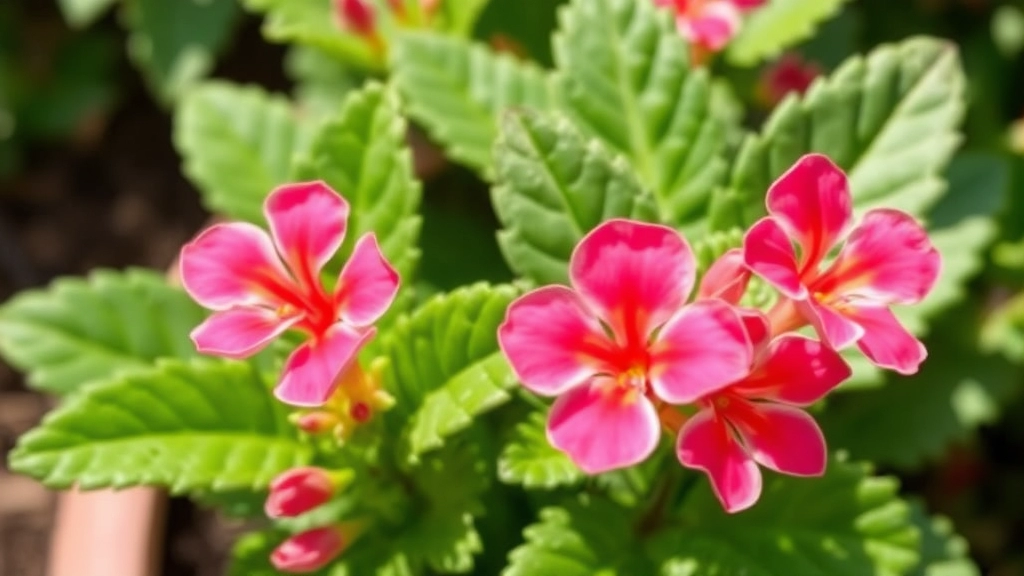
Ever noticed your Kalanchoe looking a bit crispy? Sunburn can be a real concern for these lovely succulents, especially if they’re soaking up too much sun. Don’t worry, though; I’ve got some straightforward tips to keep your Kalanchoe happy and healthy.
1. Gradual Sun Exposure
If you’re moving your Kalanchoe outdoors, do it gradually.
- Start with a few hours of morning sun.
- Gradually increase exposure over a week or two.
2. Use Shade Cloth
Consider using shade cloth during the hottest parts of the day.
- A 30-50% shade cloth can diffuse intense sunlight.
- This will protect your plant while still allowing it to soak up some rays.
3. Monitor Temperature
Keep an eye on the temperature.
- If it’s scorching outside, bring your Kalanchoe indoors or into a shaded area.
- They thrive best in temperatures between 20-25°C.
4. Water Wisely
Watering is key, especially in sunny conditions.
- Water your Kalanchoe in the morning to ensure it’s hydrated for the day.
- Avoid watering in the evening, as this can lead to excess moisture and potential rot.
5. Check for Signs of Stress
Be vigilant about checking your plant.
- If you notice yellowing leaves or browning tips, it might be too much sun.
- Adjust its placement accordingly.
Seasonal Sunlight Requirements for Kalanchoe
As we delve into the seasonal needs of Kalanchoe, it’s essential to understand how these beautiful succulents adapt to varying light conditions throughout the year.
Spring: A Time for Growth
During spring, Kalanchoe experiences a surge in growth.
- Light Requirement: Aim for 12-14 hours of bright, indirect sunlight.
- Positioning: Place them near south or west-facing windows.
- Tip: Rotate the plant weekly to ensure even light exposure.
Summer: Embrace the Sun
In summer, Kalanchoe thrives under full sun.
- Light Requirement: They can handle 6-8 hours of direct sunlight.
- Positioning: Outdoors, find a spot with morning sun and afternoon shade.
- Tip: Monitor for signs of stress, as intense heat can lead to sunburn.
Autumn: Transition Period
As autumn approaches, the light diminishes.
- Light Requirement: Gradually reduce exposure to 10-12 hours of light.
- Positioning: Move indoors if temperatures drop, ensuring they still receive ample light.
- Tip: Keep an eye on leaf colour; a shift may indicate insufficient light.
Winter: Dormancy and Care
In winter, Kalanchoe enters a dormant phase.
Artificial Lighting Options for Kalanchoe Indoors
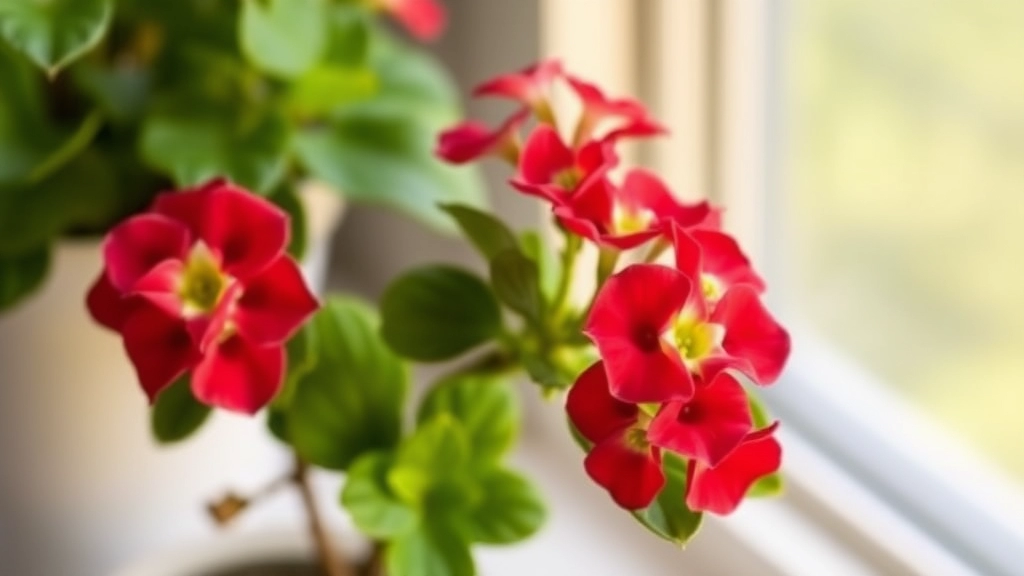
So, you’re keen on keeping your Kalanchoe thriving indoors, but what if natural light just isn’t cutting it?
Don’t worry; I’ve got you covered with some artificial lighting options that can do wonders for your plant.
Why Artificial Light?
Sometimes, our homes just don’t get enough sunlight, especially during those gloomy winter months.
Here’s how to give your Kalanchoe the light it craves:
- LED Grow Lights: These are super energy-efficient and emit the right spectrum of light for plant growth.
- Fluorescent Lights: Affordable and effective, these lights work well for Kalanchoe. Just make sure they’re the full-spectrum type.
- Incandescent Bulbs: While they can work in a pinch, they tend to produce too much heat and not enough light, so use them sparingly.
Placement Tips:
- Position your lights about 12-24 inches above the plant.
- Keep them on for about 12-14 hours a day to mimic natural sunlight.
- Rotate your Kalanchoe occasionally to ensure even light exposure.
Monitoring Growth:
Keep an eye on your plant. If it’s stretching towards the light, it might need a bit more intensity.
If it’s looking leggy or sparse, you may need to adjust the distance or duration of light exposure.
Differences in Light Needs Across Kalanchoe Varieties
When caring for Kalanchoe, understanding the specific light requirements of different varieties is crucial.
Some Kalanchoe species thrive in bright, direct sunlight, while others prefer a more shaded environment.
Here’s a breakdown of how various Kalanchoe varieties respond to light:
- Kalanchoe Blossfeldiana:
- Prefers full sun exposure.
- Requires at least 6 hours of direct sunlight daily.
- Kalanchoe Tomentosa (Panda Plant):
- Enjoys bright, indirect light.
- Too much direct sunlight can lead to leaf burn.
- Kalanchoe Luciae (Flapjacks):
- Thrives in full sun but can tolerate partial shade.
- Needs bright light for vibrant colour.
- Kalanchoe Pinnata (Mother of Thousands):
- Prefers bright, indirect light.
- Can adapt to lower light conditions but may become leggy.
- Kalanchoe Fedschenkoi:
- Enjoys bright, indirect light.
- Direct sunlight can scorch its delicate leaves.
Key Takeaways:
- Full Sun: Kalanchoe Blossfeldiana and Kalanchoe Luciae.
- Bright Indirect Light: Kalanchoe Tomentosa, Kalanchoe Pinnata, and Kalanchoe Fedschenkoi.
Understanding these differences helps ensure that each variety receives optimal light conditions, promoting healthy growth and vibrant blooms. For more specific care tips, check out our Kalanchoe Luciae care guide and our detailed Kalanchoe Pinnata guide.
Watering and Fertilizer Adjustments for Full Sun Kalanchoe
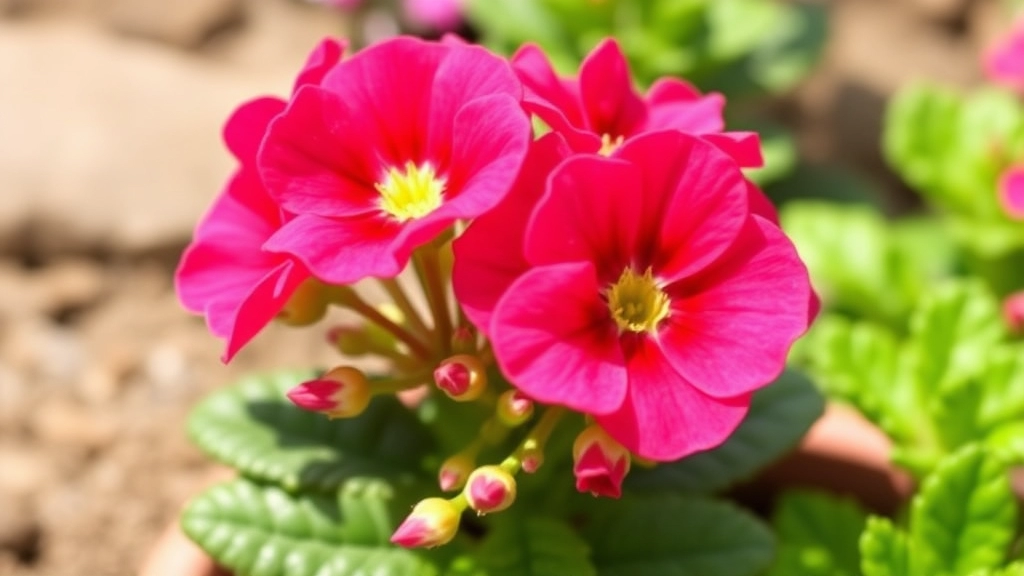
So, you’ve got your Kalanchoe soaking up all that glorious sunlight. But how do you keep it thriving in those bright, sunny conditions?
Watering Tips:
- Frequency: In full sun, Kalanchoe tends to dry out faster. Water it when the top inch of soil feels dry.
- Method: Water deeply but infrequently. This encourages strong root growth.
- Drainage: Make sure your pot has good drainage. Kalanchoe hates soggy roots!
Fertilizer Adjustments:
- Type: Use a balanced, water-soluble fertilizer. Look for something like a 10-10-10 mix.
- Frequency: Feed every 4-6 weeks during the growing season (spring and summer).
- Dilution: Always dilute the fertilizer to half-strength. Too much can burn those delicate roots.
Signs You’re Overdoing It:
- Yellowing leaves? That might be a sign of overwatering or too much fertilizer.
- Stunted growth? It could mean your Kalanchoe isn’t getting the nutrients it needs.
General Care for Kalanchoe in Bright, Sunny Conditions
After ensuring your Kalanchoe is positioned perfectly for sunlight, it’s essential to focus on its overall care in bright, sunny conditions.
Maintaining Optimal Conditions
Kalanchoe thrives in bright light, but this doesn’t mean it doesn’t require attention. Here’s how to keep your plant healthy:
- Watering:
- Allow the top inch of soil to dry out before watering.
- Water deeply but infrequently to avoid root rot.
- Fertilising:
- Use a balanced, water-soluble fertiliser every 4-6 weeks during the growing season.
- Reduce feeding in winter when growth slows.
- Temperature:
- Keep your Kalanchoe in a temperature range of 15°C to 25°C.
- Protect from cold drafts and sudden temperature changes.
Pruning and Grooming
Regular grooming can enhance your Kalanchoe’s appearance and health:
- Deadheading:
- Remove spent flowers to encourage more blooms.
- Leaf Care:
- Wipe leaves with a damp cloth to remove dust and promote photosynthesis.
Pest Management
Bright conditions can sometimes attract pests. Keep an eye out for:
- Mealybugs:
- Treat with insecticidal soap or neem oil.
- Spider Mites:
- Increase humidity around the plant and treat with appropriate solutions.
Seasonal Adjustments
As seasons change, so do your care routines:
- Summer:
- Ensure adequate watering as the heat increases.
- Winter:
- Reduce watering frequency and keep the plant in a warmer spot.
For more detailed tips on keeping your Kalanchoe healthy, check out our pruning guide and our care guide for Kalanchoe Tomentosa.
FAQs on Kalanchoe Full Sun Exposure
How do I position my Kalanchoe for full sun exposure indoors?
For indoor placement, aim for a south-facing window as it usually receives the most sunlight throughout the day. Ensure there are no obstructions like curtains or other plants blocking the light.
What are the best outdoor placement tips for Kalanchoe in hot climates?
Position your Kalanchoe where it can get morning sun and afternoon shade to prevent sunburn. Using a shade cloth and placing the plant in elevated planters can also help manage intense sunlight and heat.
How can I prevent my Kalanchoe from getting sunburned?
Gradually increase sun exposure if you’re moving the plant outdoors. Consider using a shade cloth during the hottest parts of the day and monitor the temperature closely. Water your Kalanchoe in the morning to ensure it’s hydrated for the day.
What artificial lighting options are suitable for Kalanchoe indoors?
LED grow lights and fluorescent lights are excellent options. Position the lights about 12-24 inches above the plant and keep them on for 12-14 hours a day to mimic natural sunlight.
How should I adjust watering and fertilizer for Kalanchoe in full sun?
Water your Kalanchoe when the top inch of soil feels dry, and ensure your pot has good drainage. Use a balanced, water-soluble fertilizer, feeding every 4-6 weeks during the growing season. Always dilute the fertilizer to half-strength.
What signs indicate my Kalanchoe is under stress from too much sun?
Look for yellowing leaves or browning tips, which can indicate sunburn or overexposure. Wilting leaves and discoloration are also signs of heat stress or insufficient watering.
How often should I rotate my Kalanchoe for even sun exposure?
Rotate your Kalanchoe every couple of weeks to ensure all sides receive equal sun exposure, promoting even growth.
What should I do if my Kalanchoe looks leggy or sparse under artificial light?
If your plant is stretching towards the light, it might need more light intensity. Adjust the distance or duration of light exposure to promote healthier growth.
References
-
Kalanchoe Light Requirements – Gardening Know How
-
Kalanchoe Plant Profile – The Spruce
-
How to Grow Kalanchoe – The Old Farmer’s Almanac
